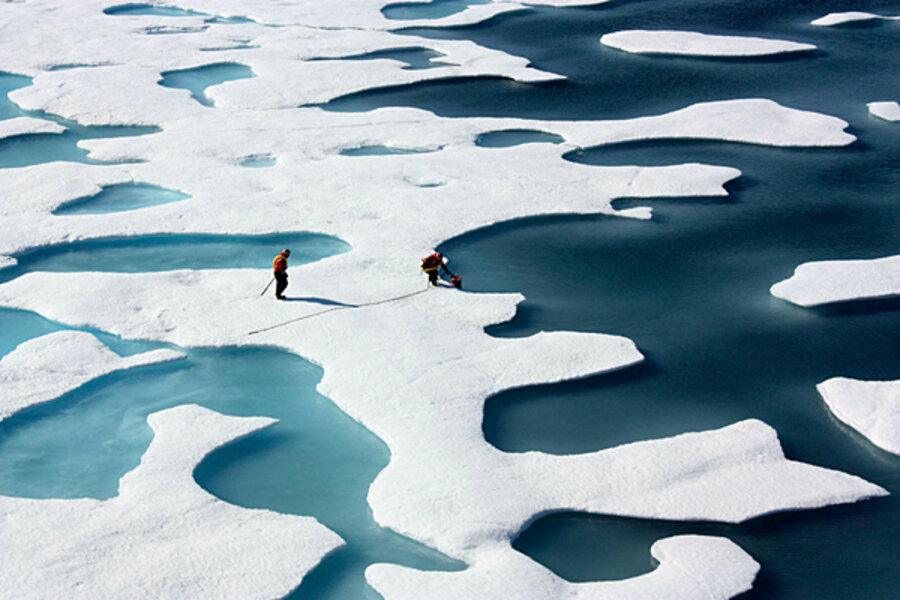China pushes for Arctic foothold, from a thousand miles away
Loading...
| Medford, Mass.
Way up above 66th parallel north, the jousting and jostling for the mother lode of oil, gas, mineral, fish, and other resources being exposed by the rapidly receding Arctic sea ice is well under way.
Russia is building a new class of nuclear icebreakers. Norway is charting fish-migration patterns for potential new fisheries. Canada is setting up a new Arctic training base and constructing a fleet of new patrol ships. US oil giants are angling to drill exploratory oil and gas wells. And China is sending its flagship icebreaker along the Northern Route.
Wait. China?
Not surprisingly, the eight nations that ring the planet’s northern cap – the United States, Canada, Russia, Finland, Sweden, Norway, Iceland, and Denmark – are the ones who have largely driven the discussion about access in the Arctic. With the exception of periodic saber-rattling or polar tub-thumping (Exhibit A: Russia’s 2007 ocean-floor flag-planting stunt), the discussions have been amicable. That’s due in large part to the 17-year-old intergovernmental agency known as the Arctic Council, which has helped soften the edges of growing competition.
“The lure of riches in the Arctic draws ever more companies and nations,” said William Moomaw, a professor of international environmental law at the Fletcher School of Law and Diplomacy in Medford, Mass. “And so far it’s been relatively amicable jousting and jostling there.”
The quickening decline of Arctic Sea ice has its own alarming implications for the globe. As Prof. Moomaw put it at the Tufts University Energy Conference Sunday: “the trend line looks like a failing stock market or the collapse of a fishery – it just keeps going down and down, and then keeps going down further.”
That aside, with the wealth of resources being unlocked by global warming, it’s not surprising that other, non-Arctic nations are increasing looking to get in on the action. The US Geological Survey estimates more than a fifth of the world’s undiscovered, recoverable oil and gas lie under the harsh, frigid, and remote conditions above the 66th parallel.
Enter China, whose northern most point in Manchuria, along the Amur River, is at least 1,000 miles south of the Arctic Circle.
Beijing last year sent the icebreaker Snow Dragon (MV Xue Long) from Shanghai to Iceland along the Northern Route, which parallels the Russian Arctic coastline and has the potential to be a shorter, cheaper route to get goods from East Asia to Europe. They’ve applied for observer status at the Arctic Council. And, according to Malte Humpert, executive director of The Arctic Institute, China has also built a swanky new, $250 million embassy in Reykjavik, Iceland, of all places.
So what's behind this push?
It’s easy to see that China would clearly like access to oil, gas, and other resources. But a more persuasive argument is that Beijing clearly wants alternate shipping routes to the Strait of Malacca. That’s the crowded 1-1/2 mile bottleneck between Indonesia and Malaysia that 60,000 ships pass through every year, according to Mr. Humpert: Sixty percent are China-bound, and 80 percent are carrying the fuels that are propelling its economic dynamo. China’s leadership is concerned enough this is a strategic vulnerability that they call the situation the “Malacca Dilemma.”
But those aren’t wholly convincing in Humpert’s estimation. The most plausible argument is that, as with many of its policies these days, the Chinese are in it for the long haul: a long-term strategy as a global emerging power.
China “is extending its reach in Africa, southwest Pacific; the Arctic is just the latest region with geopolitical significance. They can make minimal investments today and can secure strong influence in 20, 30 years,” he told a energy conference panel discussion dubbed “Arctic Anxiety.”
“China wants to have a seat at the table. They want to be part of the Arctic Council. They’re an emerging power,” he said. “They know that Arctic may be one of the hot spots of the 21st century.”





